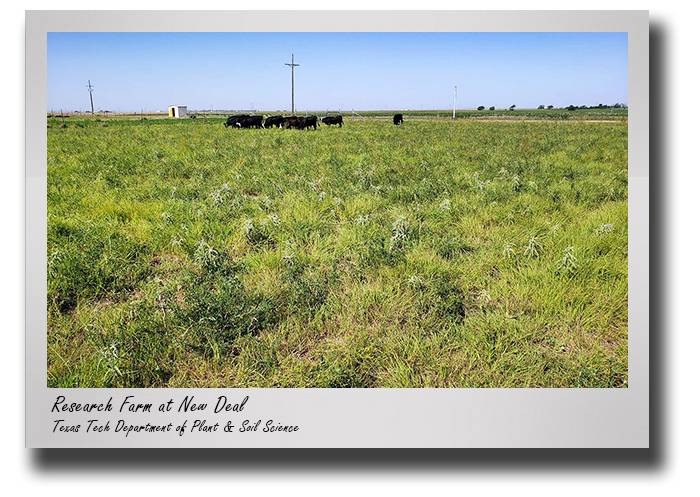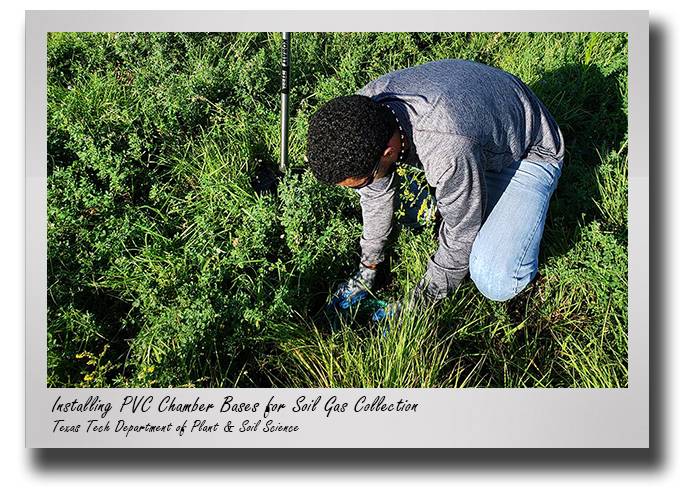Improving soil health could mitigate greenhouse gases in semi-arid region
By: George Watson
 Farming and ranching in West Texas walk a very thin line in an effort to achieve sustainability.
A combination of the semi-arid climate and scarcity of water presents a great challenge
to agricultural producers throughout the region, and a slight deviation one way or
the other often determines how profitable a growing season or herd can be.
Farming and ranching in West Texas walk a very thin line in an effort to achieve sustainability.
A combination of the semi-arid climate and scarcity of water presents a great challenge
to agricultural producers throughout the region, and a slight deviation one way or
the other often determines how profitable a growing season or herd can be.
 The key for producers is to use as little of the limited natural resources as possible,
while still improving production. That task also is the focus of many agricultural
research projects at companies and universities across the United States, including
those in Texas Tech's College of Agricultural Sciences & Natural Resources.
The key for producers is to use as little of the limited natural resources as possible,
while still improving production. That task also is the focus of many agricultural
research projects at companies and universities across the United States, including
those in Texas Tech's College of Agricultural Sciences & Natural Resources.
Leading one of those research projects is Lindsey Slaughter, an assistant professor of soil microbial ecology and biochemistry in the Department of Plant and Soil Science. Her latest project, a collaboration with fellow researchers from Texas Tech and the USDA Agricultural Research Services, is an attempt to develop new management strategies for agricultural grasslands that can improve production and soil health, conserve natural resources and reduce greenhouse gas emissions.
Her project, "Harnessing soil health to mitigate greenhouse gas emissions in semi-arid pasture ecosystems," is a collaboration with former PSS Thornton Distinguished Chair Charles West, PSS assistant professor of soil physics Sanjit Deb and Veronica Acosta-Martinez, a soil scientist and microbiologist with the USDA-ARS Cropping Systems Research Lab in Lubbock.
The project is backed by a $500,000 grant from the USDA's National Institute of Food and Agriculture Cooperative State Research Education and Extension Service. Based on preliminary data, the group hopes to show, through greenhouse gas manipulation and field measurements, how nutrient and forage management controls how much enteric methane (CH4) is absorbed by the soil while improving soil health.
"One of the ways our results will immediately help producers is by showing whether planting both perennial grasses, such as old-world bluestem, and nitrogen-adding legumes, namely alfalfa and sweet clover, helps the soil to absorb methane better than planting only grasses that need nitrogen fertilizer to be productive and may even produce methane rather than absorb it," Slaughter said.
"This will help us show producers how what they plant in perennial grasslands can not only save water and reverse soil degradation, but also help soil microbes that shrink their climate footprint and make sure these systems can stay profitable long-term," she said.
Utilizing the Texas Tech's Research Farm at New Deal, West has developed pasture systems that could help farmers adapt or transition to dryland farming in a semi-arid region. Acosta-Martinez is a long-time collaborator with West and many others in PSS who studies soil health in these pastures and similar systems. Deb has conducted previous research at the facility to understand how management affects water movement in soil and has studied soil greenhouse gas emissions.
Slaughter said her goal for this project is to discover how soil microorganisms in these pastures can be managed to help offset some of the methane emissions from grazing cattle.
 "It is exciting to add another piece of the puzzle in understanding how to manage
these ecosystems to be more productive and have healthy soils under expected climate
variability in this region, which also relies on mitigating greenhouse gases," Acosta-Martinez
said. "Most of the farmers I've talked to are concerned about the next drought and
how they can build their soil microbiome and resilience to cope with this and stay
profitable long-term. Research like this helps us plan for the future."
"It is exciting to add another piece of the puzzle in understanding how to manage
these ecosystems to be more productive and have healthy soils under expected climate
variability in this region, which also relies on mitigating greenhouse gases," Acosta-Martinez
said. "Most of the farmers I've talked to are concerned about the next drought and
how they can build their soil microbiome and resilience to cope with this and stay
profitable long-term. Research like this helps us plan for the future."
 According to the research proposal, one sustainable and economically feasible management
option used in the past is converting land used for growing row crops into grazed
perennial grasslands. This provides high-quality forage for production animals while
improving soil health and conserving water and other natural resources by minimizing
disturbance and adding soil cover.
According to the research proposal, one sustainable and economically feasible management
option used in the past is converting land used for growing row crops into grazed
perennial grasslands. This provides high-quality forage for production animals while
improving soil health and conserving water and other natural resources by minimizing
disturbance and adding soil cover.
By adding production animals to the area, however, there is an increase in methane emitted. The researchers propose, though, based on previous research, that adding legumes can increase soil microbial uptake of the methane and improve forage quality for livestock, improving resource efficiency, sustainability and productivity.
"Even though the sight of cattle grazing in pastures looks like a simple way of farming, achieving profitability is anything but simple," Deb said. "Perennial grasses and legumes can be managed to improve the soil's ability to store scarce water and nutrients. The right mix of invisible soil microbes can help grazed forages conserve those valuable inputs, while reducing the production of gases that lead to climate warming. This project will use our field results to develop a computer model that predicts how water supply, fertilization and grazing management affect greenhouse gases. Results will guide cattle managers in how best to sustain production while reducing possible impacts of cattle on climate change."
Slaughter said this project will use long-term forage treatments in grazed semi-arid pastures to determine how management regulates soil greenhouse gas fluxes. The data collected from the soil in this study, as well as paired plant and animal growth data from the site, will be used to model greenhouse gas dynamics under different management and environmental scenarios.
The goal of the research is to develop new management strategies that reduce greenhouse gas emissions from agricultural grasslands, allowing land managers and consumers to benefit from sustainable food systems with a lower climate footprint and better stewardship of natural resources.
"The grant supports research at the crossroads of water scarcity, soil health, climate, meat production and economic viability of the Texas High Plains," West said. "It seeks to answer questions on the subtle effects of soil microbes on controlling the absorption and release of greenhouse gases from pasture soils. This is critical information because it shapes economic decisions on how a living soil can be used as pasture to support beef production with low water input and reduced environmental impact."
CONTACT: Lindsey Slaughter, Assistant Professor of Soil Microbial Ecology/Biochemistry, Department of Plant and Soil Science, College of Agricultural Sciences and Natural Resources, Texas Tech University at (806) 834-1345 or lindsey.slaughter@ttu.edu
0310NM21
Davis College NewsCenter
-
Address
P.O. Box 42123, Lubbock, Texas 79409-2123, Dean's Office Location:Goddard Building, Room 108 -
Phone
(806)742-2808 -
Email
kris.allen@ttu.edu
